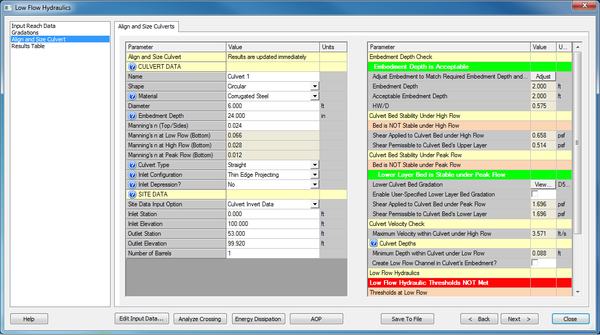HY8:LOWFLOW SS Align and Size Culvert
Low Flow Hydraulics, Align and Size Culvert
This dialog will allow the user to make changes to the layout and size of the culvert and immediately see the results in the Low Flow Hydraulics Results Table.
Align and Size Culverts
The left side of the dialog contains the same spreadsheet that is available on the right side of the Crossing Input Data dialog. Any changes made on this page, will change the data that is shown in that dialog. There is no undo or cancel on this page. More information is available at Culvert Data
Results if Gradation is Included
Embedment Depth Check
The right side of the dialog reports the Aquatic Organism Passage results. It starts with the embedment level. The level of embedment depends on the layers that are required, the gradations of those layers, and the shape of the culvert. There is a button that will adjust the embedment to match the required amount of embedment. This may change the invert elevations of your culvert as well as the embedment depth. The headwater depth over culvert rise, HW/D, is also reported in this section so the user can verify that the culvert still meets hydraulic design criteria. This calculation does not include the section of culvert that is embedded when calculating the rise and the headwater depth.
Culvert Bed Stability Under High Flows
Next is the stability of the culvert bed under high flow. First, it checks if the culvert bed's upper layer is stable under high flow. It does this by comparing the shear applied to the shear permissible to the culvert bed's upper layer. If the permissible shear is greater, then it is stable. If that fails, the bed mobility may still be acceptable. First HY-8 determines if the streambed is mobile. If the applied shear on all cross section are above the permissible shear, then all cross section will be eroding and the streambed will be mobile. If the bed is mobile and as long as the shear applied to the culvert bed, is less than the maximum shear applied to the cross sections immediately upstream or downstream of the culvert crossing, then the mobility is acceptable. If the bed is NOT mobile or if the culvert's shear is higher than the maximum shear in the cross sections, it is not acceptable.
For more information on the optimize button, see below.
Culvert Bed Stability Under Peak Flows
The next section is where HY-8 checks the stability of the culvert bed under peak flow. First it checks if the culvert bed's upper layer is stable under peak flow. It does this by comparing the shear applied to the shear permissible to the culvert bed's upper layer. If the permissible shear is greater, then it is stable. If it is unstable, HY-8 will determine the gradation that will be stable. The user can then specify their own gradation to be used in the calculations. For the user's ability to compare, the maximum shear applied to the reach cross section under peak flow is reported, although it is not used in these calculations.
Culvert Velocity Check
The third check is the velocity under high flow. HY-8 determines the maximum average velocity within the barrel when it determines the water surface elevations through direct step. It then compares this velocity with the maximum average velocity computed using the Manning's Equation at the cross sections. As long as the culvert's velocity is less than the velocity in the cross sections, the velocity is acceptable.
Culvert Depths
The final check is the depth in the culvert under low flow. HY-8 determines the minimum depth within the barrel when it determines the water surface elevations through direct step. It then compares the minimum depth in the culvert, with the minimum depth in the cross section that is computed by the Manning's Equation.
If the depth is too shallow, the user can create a low flow channel in the embedment. The side slope of the low flow channel is 1:8 (V:H), but the depth can be adjusted by the user. The shape of the embedded culvert will be modified in the computations and in the front view of the culvert. This change will affect the computations in the Culvert Crossing Output dialog as well.
Low Flow Hydraulics Results
There are three results given for both flows. The combined width of the slices that meet threshold depth and velocities, the highest average velocity, and the lowest depth in the culvert.
